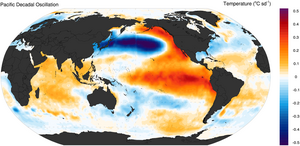
Back التذبذب العقدي للمحيط الهادئ Arabic Pacifická dekádová oscilace Czech Pazifische Dekaden-Oszillation German Pacifika jardeka oscilado Esperanto Ozeano Bareko Hamar urteko Oszilazio Basque Oscillation décennale du Pacifique French Oscillazione pacifica decadale Italian 太平洋十年規模振動 Japanese Oscillazion decennal del Pacifich LMO Den tiårige svinginga i Stillehavet NN
This article has multiple issues. Please help improve it or discuss these issues on the talk page. (Learn how and when to remove these messages)
|

The Pacific decadal oscillation (PDO) is a robust, recurring pattern of ocean-atmosphere climate variability centered over the mid-latitude Pacific basin. The PDO is detected as warm or cool surface waters in the Pacific Ocean, north of 20°N. Over the past century, the amplitude of this climate pattern has varied irregularly at interannual-to-interdecadal time scales (meaning time periods of a few years to as much as time periods of multiple decades). There is evidence of reversals in the prevailing polarity (meaning changes in cool surface waters versus warm surface waters within the region) of the oscillation occurring around 1925, 1947, and 1977; the last two reversals corresponded with dramatic shifts in salmon production regimes in the North Pacific Ocean. This climate pattern also affects coastal sea and continental surface air temperatures from Alaska to California.
During a "warm", or "positive", phase, the west Pacific becomes cooler and part of the eastern ocean warms; during a "cool", or "negative", phase, the opposite pattern occurs. The Pacific decadal oscillation was named by Steven R. Hare, who noticed it while studying salmon production pattern results in 1997.[1]
The Pacific decadal oscillation index is the leading empirical orthogonal function (EOF) of monthly sea surface temperature anomalies (SST-A) over the North Pacific (poleward of 20°N) after the global average sea surface temperature has been removed. This PDO index is the standardized principal component time series.[2] A PDO 'signal' has been reconstructed as far back as 1661 through tree-ring chronologies in the Baja California area.[3]
- ^ Mantua, Nathan J.; Hare, Steven R.; Zhang, Yuan; Wallace, John M.; Francis, Robert C. (1997). "A Pacific interdecadal climate oscillation with impacts on salmon production". Bulletin of the American Meteorological Society. 78 (6): 1069–79. Bibcode:1997BAMS...78.1069M. doi:10.1175/1520-0477(1997)078<1069:APICOW>2.0.CO;2.
- ^ Deser, Clara; Alexander, Michael A.; Xie, Shang-Ping; Phillips, Adam S. (January 2010). "Sea Surface Temperature Variability: Patterns and Mechanisms". Annual Review of Marine Science. 2 (1): 115–143. Bibcode:2010ARMS....2..115D. doi:10.1146/annurev-marine-120408-151453. PMID 21141660.
- ^ Biondi, Franco; Gershunov, Alexander; Cayan, Daniel R. (2001). "North Pacific Decadal Climate Variability since 1661". Journal of Climate. 14 (1): 5–10. Bibcode:2001JCli...14....5B. doi:10.1175/1520-0442(2001)014<0005:NPDCVS>2.0.CO;2.